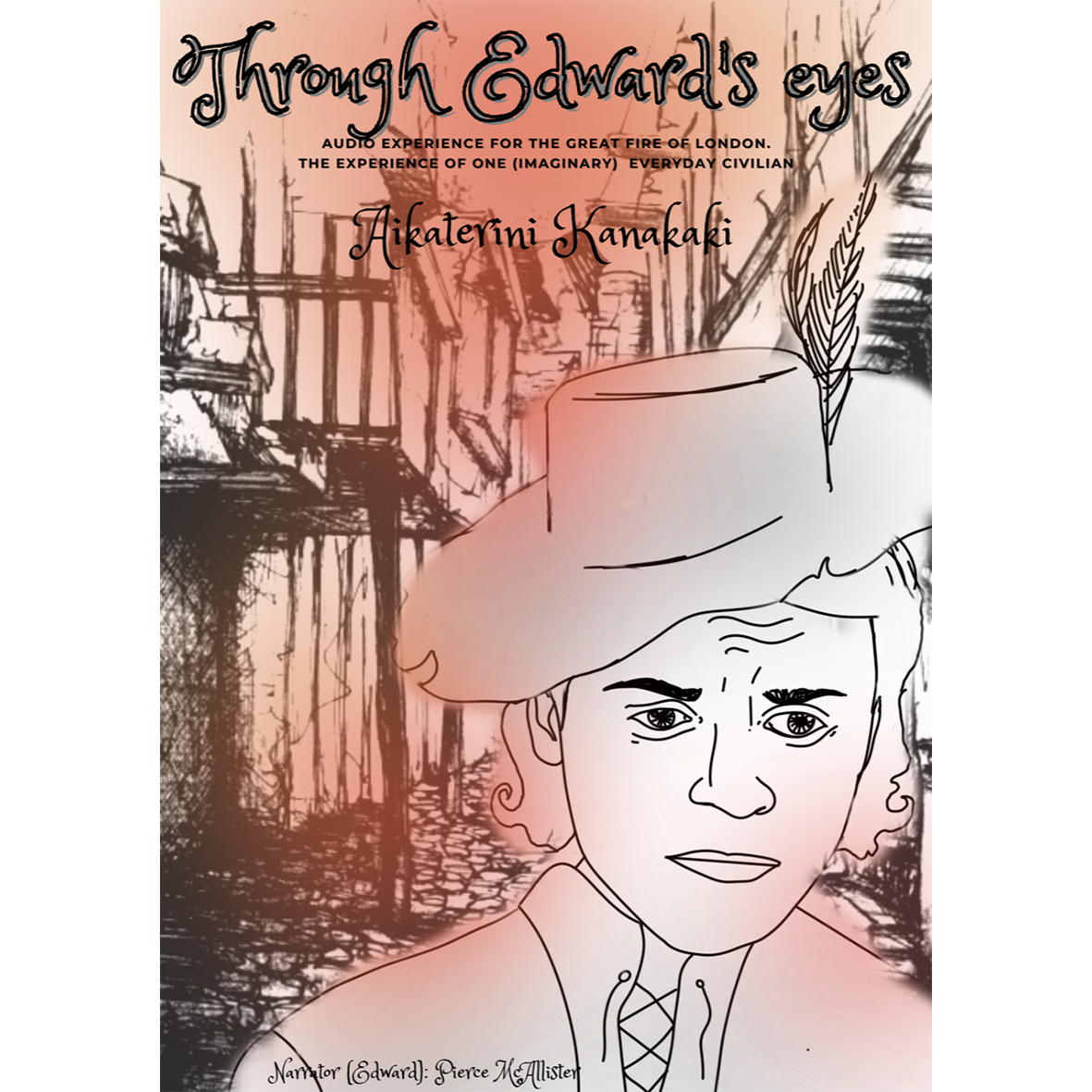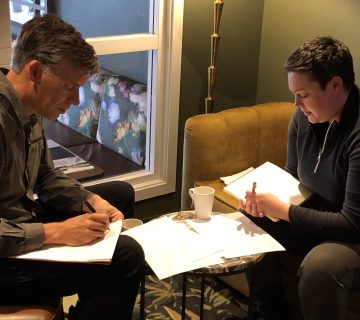Digital technology was used during the Covid-19 pandemic to give students a practical and creative insight into work in the cultural sector.
Over the summer of 2021, teams from Tower Bridge and The Monument to the Great Fire of London, and London Metropolitan University collaborated to make use of the possibilities afforded by digital technology in a project to continue to engage students when face-to-face interaction was not possible.
1. Planning the collaboration and objectives
David Laird, Tower Bridge and The Monument, Learning Officer
Plans for a collaboration between The Monument and London Metropolitan University MA Public Art & Performance were first mooted during the early stages of the 2020 Covid-19 lockdown. Prior to this, our formal learning programme at The Monument focused on primary school students (age 5-7) studying the Great Fire of London. With the ongoing closure of schools and The Monument, we decided to diversify the reach of our programme through a series of partnerships.
Our collaboration with the MA course utilised the summer module, ‘Public Art and Performative Practices’. It provides students with an introduction to the practical journey of artistic, cultural and ethical considerations in creating works of public art and performative practices. With these aims in mind, we drafted a proposal, in collaboration with our Exhibition Development Manager, setting students the problem-solving brief of ‘developing an engagement opportunity for The Monument based around the business impact parameters created by Covid-19.’
The partnership provided a fantastic opportunity to deliver against our Learning Framework and objectives for formal learning, which were to:
- Widen the reach of The Monument learning programme
- Build working partnership with local higher education institutions
- Provide an offer for The Monument during closure
- Increase collaborative internal teamworking between Learning & Exhibitions
The project was delivered in three key sessions. The first, led by the Learning team, focused on students gaining an understanding of The Monument’s historical themes and stories. The second, led by our Exhibition Development Manager, focused on providing students with an exploration of why and how we develop and deliver audio interpretation, including the interpretive principles and disciplines used, parameters (including budgets) and practicalities required to create audio interpretation. The third session saw the students present their responses to the brief and receive feedback.
2. The practical, and creative, part
Dirk Bennett, Tower Bridge and The Monument, Exhibition Development Manager
A key consideration of the collaboration was to give students an experience as realistic and practical as possible – based on a typical brief and informed by examples from the real world of heritage and museum interpretation and learning.
Having worked in the past for an audio and multimedia production company (Antenna Audio), we used audio tours to illustrate principles, approaches and processes – and limitations! – in the production of sound-based experiences for the students to use them in their own projects.
A structured, carefully planned approach with clearly defined objectives, audiences and outcomes forms the basis for a successful project: this will also help to channel creative ideas in a much more directed way.
In this case it meant helping students to define the specific aims and objectives of their commission from the outset: namely, to provide an engaging and accessible audio experience; tailored for visitors; with a focus on clear themes and stories; and the audio experience as the narrative device.
To enable students to research and then design their take on an audio experience we defined the key deliverables: to provide a summary/concept of the overall experience; and specifically design three stops including an intro and two stops based on any of The Monument’s main interpretation themes: The Great Fire of London in 1666; rebuilding London in the aftermath; building The Monument between 1671 and 1677; Robert Hooke and Christopher Wren, its builders; The Monument in popular culture; Monument-related stories and anecdotes.
Over the course of a session we discussed with the students the core aspects in the planning of such a project: how to define their audience segment; the route and overall duration; how to start and end the experience; practicalities, such as help and instructions; accessibility; the recommended length and total number of stops, which in turn relates to questions of attention span and recommended maximum number of key facts per stop (no more than 2-3); the possibility of layering information; suitable content types; the importance of the use of visual clues; creative approaches; linearity (or not); the narrative style: the emphasis on the spoken word, not literal; and, related to that: the choice of voice talent and its practicalities; the efficient use of supporting assets, such as interviews, quotes, images, music and SFX; legal considerations when using any of these and the consideration of copyright and licenses.
Altogether a mix of practical, formal and creative considerations, legal and accessibility requirements that are also transferable to any element of and in an exhibition.
Accompanying samples from tours developed for the Hampton Court Drama and Debate audio experience served as examples for these varying aspects of the planning and development process.
The final session several weeks later, in which students presented their work with supporting slides and audio files, brought an impressive range of creative responses; carefully considered and covering varying aspects of themes related to The Monument.
3. The view from the university
Jacek Ludwig Scarso, London Metropolitan University, Reader in Art and Performance
Our MA Public Art & Performance, launched at London Metropolitan University in September 2020, explores how notions of publicness and performance can continue to be reframed in an art context, producing new opportunities for social engagement. Within this vision, the possibility of collaborating with case study institutions is paramount in providing students with real-life situations, to which they can apply their creative strategies in both speculative and fully realised projects. Whilst opening a new course in the midst of a pandemic brought a range of inevitable challenges, it is through such collaborations that the pedagogical emphases of the programme not only have not been compromised, but have been usefully tailored to a changing landscape of visitor experiences.
Our collaboration with The Monument to the Great Fire of London has confirmed this potential, establishing a productive dialogue that has been both creatively stimulating and professionally relevant. Key to the collaboration have been the perspectives offered by The Monument’s professional team, giving students significant insight into the workings of such an institution, the fascinating history behind it and, crucially, the challenges that cultural sites like The Monument have experienced, particularly with the uncertainty of Covid-19.
Furthermore, the diverse expertise provided by the team has inspired the students with useful, hands-on advice on public engagement strategies, curatorial methods and interpretation tools.
In our first instalment of this collaboration (one that we hope to be the first of many more), the students engaged with particular contextual angles in the production of original concepts for audio experiences, designed both to inform the public on the history of the site and to reflect on cultural and ideological questions deriving from this. For each audio experience, students were required to actively identify suitable audiences and to make their work relevant to these, whilst keeping the experience as accessible as possible. The resulting projects reflected an impressive range of approaches: from family-friendly fictional narratives recounting the events of the Great Fire of London and the legacy of The Monument as a site of scientific experimentation, to experimental sound installations, raising questions of gender, cultural identity and social hegemony embedded in historical landmarks such as The Monument. Indeed, the notion of ‘monumentality’ itself, so intrinsic to this location, provided a stimulus for discussion as to the changing connotations of this term in the 21st century.
Overall, the strength of projects like this lies in the exploration of a historical landmark as a multi-layered entity, whereby each ‘layer’ provides a different angle, question or approach that may be creatively explored. It is by appreciating and carefully analysing each layer, through the expert insight of the professionals who know the site inside-out but are equally open to new perspectives on this, that dynamic ideas of public engagement can originate and flourish.
In summary, this collaboration highlighted not only the importance of maintaining the link between the practical and the academic, between study and a glimpse of working in the cultural sector; it also provided both institutions with the opportunity to deliver their key objectives to their mutual benefit. And finally, it can serve as an example how, even during that period of a world in lockdown, things can still be achieved through the imaginative and creative use of technology.
Dirk Bennett is the Exhibition Development Manager for Tower Bridge and The Monument in London, UK. Originally from Germany, he has been in the UK since 1994. He holds an MA in history and archaeology and has worked in the cultural sector for private and public bodies. He writes extensively for publications in the UK and Germany as a freelance author and cultural correspondent. He can be contacted at: dirk.bennett@cityoflondon.gov.uk.
David Laird is the Learning Officer for Tower Bridge and The Monument in London, UK. Born and raised in Edinburgh, Scotland. Having completed an MA(hons) in Scottish History at University of Glasgow, he has worked in the museums and heritage sector for the last 15 years. He currently leads on the development of learning programmes at The Monument to the Great Fire of London. He can be contacted at: david.laird@cityoflondon.gov.uk
Dr Jacek Ludwig Scarso is Reader in Art & Performance at London Metropolitan University, where he leads the MA Public Art & Performance and is Deputy Director of CREATURE (Research Centre for Creative Arts, Cultures and Engagement). He can be contacted at: j.scarso@londonmet.ac.uk.
For more details on the MA Public Art & Performance, visit
https://www.londonmet.ac.uk/courses/postgraduate/public-art-and-performance—ma/.




